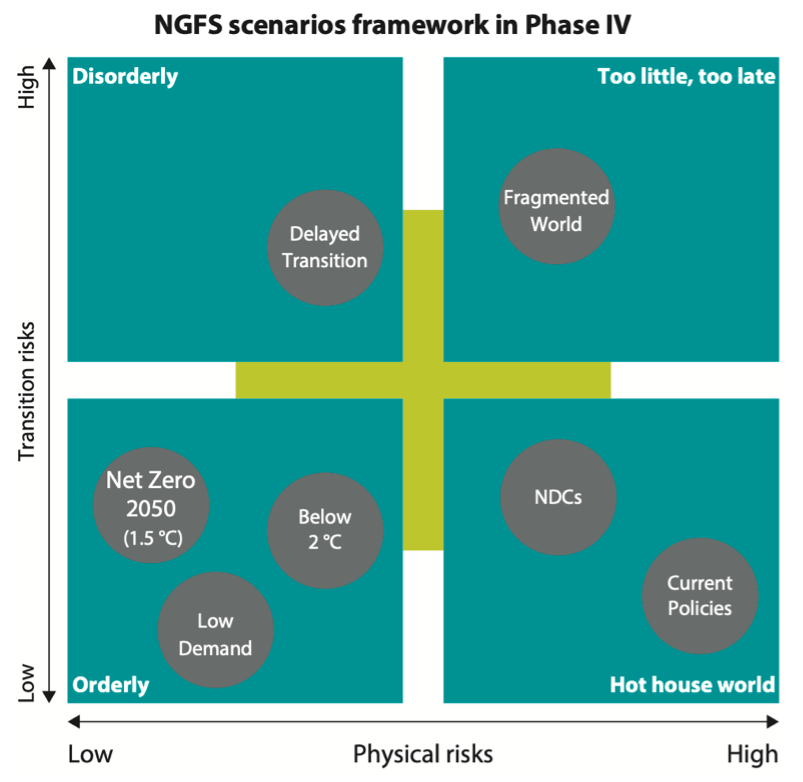The Network for Greening the Financial System
NGFS has developed a set of six reference climate scenarios that serve as a common ground for financial institutions and regulators to assess and manage financial risks and opportunities associated with climate change (NGFS, 2023b). All scenarios share the same set of basic assumptions according to SSP2[1], where social, economic, and technological trends do not shift markedly from historical patterns. However, NGFS’ scenarios complement SSP2’s assumptions with scenario-specific climate policies that aim to reduce the impact of climate change to different extents (NGFS, 2023a). In practice, climate policies are proxied as a carbon tax, of which severity, time of implementation, and coordination across sectors and countries differ across scenarios. In addition to implementing a carbon tax, the pace of technological development and levels of carbon dioxide removal technologies also vary across scenarios (see Figure). NGFS scenarios are paired into four categories that represent different levels of climate-related risks (i.e., transition and physical risks; NGFS, 2023a)[2]:
Orderly transition scenarios:
Three scenarios assume that climate policies are applied immediately and coordinated: “Below 2ºC”, “Net Zero 2050”, and “Low Demand”[3]. These scenarios allow global warming to remain limited (low physical risks) and avoid serious transition risks. While the Net Zero 2050 scenario aims to reach zero emissions by 2050, the Below 2ºC scenario wants to keep the global temperature rise below 2 degrees Celsius by 2100. Thus, carbon taxes are higher in the more ambitious Net Zero 2050 scenario.Disorderly transition scenario:
One scenario estimates the effects of policies and carbon taxes being applied late (i.e., in 2030): “Delayed Transition”. To keep global warming below two degrees Celsius and compensate for the delay would require much stronger policies than in orderly scenarios. While such policies would keep physical risks low, carbon taxes are introduced as a shock and increase sharply, entailing high transition risks.Too little too late scenario (insufficient transition):
The fifth scenario describes another scenario in which efforts to mitigate climate change are made too late and uncoordinated: “Fragmented World”. The efforts in this scenario generate not only transition risks but also fail to limit physical risks.Hot house world scenarios (no transition):
Two scenarios describe the effects of climate policies remaining the same as they are today (“Current Policies”) or being implemented insufficiently and lacking coordination across countries (“Nationally Determined Contributions” – NDC). In these scenarios, global warming is not contained, and transition risks are low but at the cost of high physical risks.

Overview of the NGFS scenarios positioned according to their level of
physical (x-axis) and transition risks (y-axis; NGFS, 2023b, p. 8)
It needs to be noted that NGFS proxies climate policies in the IAMs as carbon taxes. In each scenario, carbon taxes differ in severity, time of implementation, and coordination across sectors and countries. In addition, the pace of technological developments and levels of carbon dioxide removal technologies vary across scenarios.
[1] SSPs so-called “Middle of the Road” narrative assumes that current policies and trends continue without significant deviation and a future with moderate economic growth, stable population, and technological progress. The use of bioenergy with carbon capture and storage (BECCS) is low, and GHG concentrations roughly correspond to the RCP4.5 scenario (one of the RCP scenarios with an expected radiative forcing of 4.5W/m2; Fricko et al., 2017).
[2] NGFS released the first vintage of scenarios in 2020 and has updated its predictions annually. We use the fourth vintage of NGFS scenarios (version 4.2), which was released in March 2024 and provides seven scenarios (NGFS, 2023b).
[3] We do not discuss the “Low Demand” scenario, as it is still under development and misses some macroeconomic variables (as of January 2024).
Fricko, O., Havlik, P., Rogelj, J., Klimont, Z., Gusti, M., Johnson, N., … Riahi, K. (2017). The marker quantification of the Shared Socioeconomic Pathway 2: A middle-of-the-road scenario for the 21st century. Global Environmental Change, 41, 251-267. https://doi.org/10.1016/j.gloenvcha.2016.06.004
NGFS (2023a). NGFS climate scenarios. Technical Documentation. V4.2. Network for Greening the Financial System. https://www.ngfs.net/sites/default/files/media/2024/01/16/ngfs_scenarios_technical_documentation_phase_iv_2023.pdf
NGFS (2023b). NGFS scenarios for central banks and supervisors. Network for Greening the Financial System. https://www.ngfs.net/sites/default/files/medias/documents/ngfs_climate_scenarios_for_central_banks_and_supervisors_phase_iv.pdf
